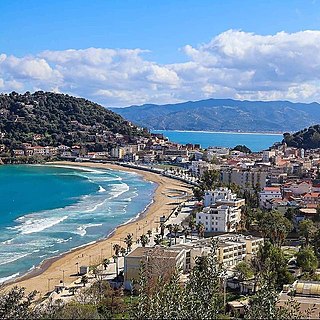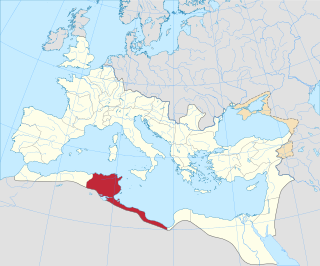Related Research Articles

Djémila, formerly Cuicul, is a small mountain village in Algeria, near the northern coast east of Algiers, where some of the best preserved Roman ruins in North Africa are found. It is situated in the region bordering the Constantinois and Petite Kabylie.

Musti or Mustis was an ancient city and bishopric in the Roman province of Proconsular Africa, now in northern Tunisia. Its ruins, called Mest Henshir, are about eight miles from Dougga, near Sidi-Abd-Er-Rebbou. It is also a Catholic titular see.
Assuras, sometimes given as Assura or Assur, was a town in the Roman province of Proconsular Africa.

Collo was an ancient Roman– a city of the Ottoman empire and Berber. Located in the northern Skikda Province, Algeria. It was the capital and one of three municipalities of Collo District, and a Catholic titular episcopal see under its Roman name Chullu'. In 1998, it had a population of 27,800.
Aïn Tine or Aïn Tinn is a town and commune in Mila Province, Algeria. At the 1998 census it had a population of 6653.

Girus Tarasii was a town in the Roman province of Numidia that became a residential episcopal see. It is tentatively identified with ruins situated at what is now called Henchir-Tarsa in Algeria.
Azura was an ancient civitas and bishopric in Roman North Africa– It remains only as Latin Catholic titular see.
Nicives, identifiable with N'Gaous in Batna Province, Algeria, was an ancient Roman town of the Roman province of Numidia.

Aquae Sirenses, also known as Aquaesirensis, is an ancient Roman colonia and a modern titular see of the Roman Catholic Church in Algeria.
Zattara was an ancient Roman and Byzantine town in the Africa province. It was located in present-day Kef ben-Zioune, south-east of Calama, Algeria. The city was a titular see of the Roman Catholic Church.

Lamzella was a civitas (town) in the Roman–Berber province of Numidia. It has been tentatively identified with the ruins at Henchir-Resdis in modern Algeria.
Theudalis, also known as Teudali, was a Roman era civitas (town) of the Roman province of Africa Proconsularis. The ancient city is tentatively identifiable with ruins at Henchir-Aouam in Tunisia.

The Diocese of Sinnuara is a sede soppressa and titular see of the Roman Catholic Church. The bishopric is suffragan to the Archdiocese of Carthage.
Henchir-Khachoum is a locality and series of archaeological sites in Sidi Bouzid Governorate modern Tunisia. The ruins are strewn along a tributary of the Oued El Hatech river east of Sbeitla. During the Roman Empire there was a Roman town of the Roman province of Africa Proconsularis, called Muzuca, one of two North African towns to bare that name.
Rusubbicari was a Phoenician and Carthaginian colony and Roman town. It has been tentatively identified with ruins at Zemmouri El Bahri, Algeria. The Roman town was in the province of Mauretania Caesariensis.
Vegesela was an Ancient city and former bishopric in Roman North Africa and remains a Latin Catholic titular see.
Satafi, was a Roman town in the Roman province of Mauretania Caesariensis, North Africa. It lasted through the Vandal Kingdom and Roman Empire, until at least the Muslim conquest of the Maghreb, in late antiquity. An exact location of the town is not known but, it was probably in Algeria.

The Diocese of Pudentiana is a suppressed and titular see of the Roman Catholic Church. It was centered on the Roman town of Pudentiana that flourished in the province of Numidia, Roman North Africa, through the Vandal Kingdom and Roman Empire of late antiquity.
Sicilibba was an ancient Roman town of the Roman province of proconsular Africa. The ancient town is tentatively identifiable with the ruins at Alaouine in today's Tunisia.
The Diocese of Vittoriana is a suppressed and titular see of the Roman Catholic Church.
References
- ↑ "What is a Titular See? | Simply Catholic". 18 August 2021.
- 1 2 Sophrone Pétridès, The Catholic Encyclopedia10, 1911
- ↑ Augustine (Bishop of Hippo) Expositions of the Psalms (New City Press, 2000) p125.
- ↑ J. Mesnage, L'Afrique chrétienne:Évêchés & ruines antiques (Paris 1912), pp. 118 and 424
- ↑ Annuario Pontificio 2013 (Libreria Editrice Vaticana, 2013, ISBN 978-88-209-9070-1), p. 935
- ↑ Pius Bonifacius Gams, Series Episcoporum Ecclesiae Catholicae, (Leipzig, 1931), p. 467.
- ↑ Stefano Antonio Morcelli, Africa Christiana, Volume I, (Brescia, 1816), p. 236.
- ↑ J. Mesnage, L'Afrique chrétienne, (Paris, 1912), p. 424.